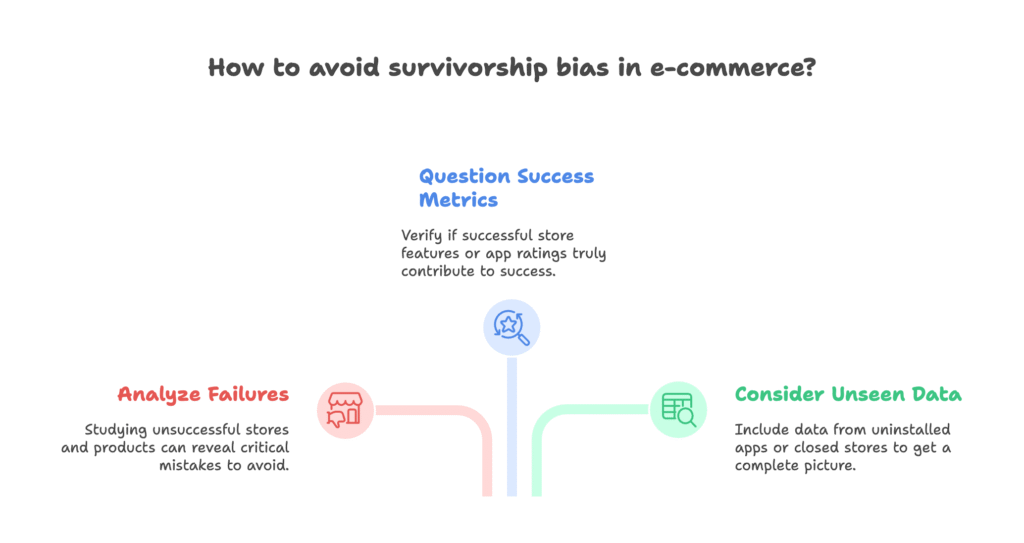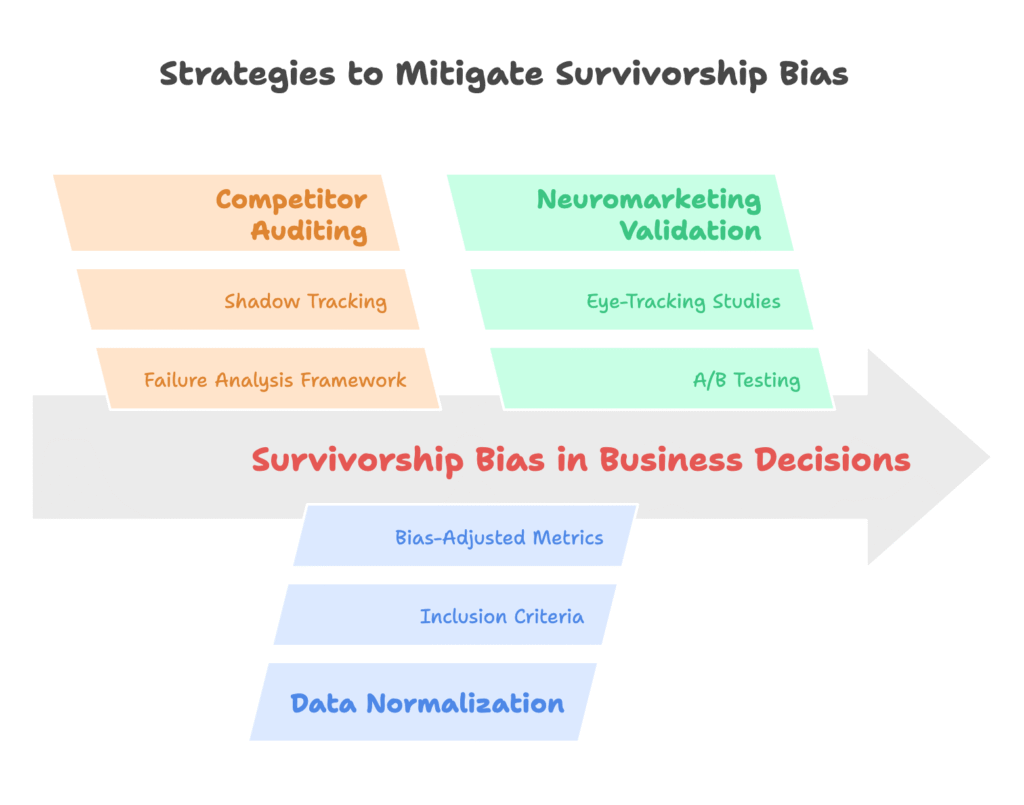Ever looked at a successful Shopify store and thought, “I’ll just copy what they’re doing”? You’re not alone. But what if I told you this common approach could be leading you straight into a trap? A trap that’s invisible until you’ve already fallen in.
This trap has a name: survivorship bias. It’s the reason why copying “successful” competitors often fails, why that “must-have” app might be tanking your conversions, and why your beautiful new theme isn’t performing as promised.
By the end of this article, you’ll:
- Understand how survivorship bias is secretly sabotaging your store’s performance
- Learn to spot the “hidden failures” your competitors don’t want you to see
- Master practical techniques to make truly data-driven decisions (not biased ones)
- Implement a simple framework that transforms how you evaluate apps, themes, and products
Ready to see what your competitors are hiding? Let’s dive in!
Understanding Survivorship Bias in E-Commerce
Before we can fix the problem, let’s understand what survivorship bias actually is and why it matters so much to your Shopify store.

Definition & Historical Context
Survivorship bias is our tendency to focus exclusively on the people, things, or strategies that “survived” a selection process while completely overlooking those that didn’t.
The classic example comes from World War II. When military engineers analyzed returning bomber planes to determine where to add armor, they initially focused on the areas with the most bullet holes. But statistician Abraham Wald pointed out a crucial insight: they were only looking at the planes that survived and made it back. The planes that didn’t return likely had damage in other areas—the exact places that actually needed reinforcement!
In e-commerce, we make the same mistake all the time. We study successful stores, trending products, and top-rated apps while completely ignoring the far larger graveyard of failures that could teach us what to avoid.
Neural Basis of Bias
Our brains are actually wired for this bias. Our prefrontal cortex (the part that handles decision-making) loves to prioritize visible success markers. Meanwhile, our amygdala creates an aversion to analyzing failure patterns—it’s simply less pleasant to study what went wrong!
This combination creates a perfect storm where we naturally gravitate toward studying “winners” while actively avoiding examining the far more numerous “losers.”
Shopify-Specific Risks
In the Shopify ecosystem, this bias manifests in two dangerous ways:
- Over-optimization based on “successful” store features: Copying layouts, copy, or images from top stores without understanding if these elements actually caused their success
- Misinterpretation of app/store performance metrics: Taking app store ratings at face value without considering that strugglers likely uninstalled and never left reviews
Think about it: for every thriving Shopify store you admire, there are dozens (perhaps hundreds) that failed using similar strategies. What lessons are you missing by studying only the survivors?
Now that we understand what survivorship bias is, let’s see how it specifically distorts your competitor analysis and leads you down potentially dangerous paths. The patterns might surprise you…
How Survivorship Bias Distorts Shopify Competitor Analysis
Let’s get practical and see exactly how this bias undermines your competitor research efforts. What you can’t see really can hurt you.
Common Pitfalls
The most dangerous aspect of survivorship bias is how it creates blind spots in your analysis. Here’s what’s typically happening:
| What You See | What You Don’t See | The Real Impact |
|---|---|---|
| Successful store designs | Failed stores’ UX experiments | You adopt trends that actually drive customers away |
| Top-performing apps | Abandoned apps with 1-star reviews | You waste money on tools that secretly hurt conversion |
| Viral product launches | 90% of failed product launches | You overestimate market potential and overinvest |
The stores you’re studying represent only the tip of the iceberg—a tiny fraction that survived while most sank beneath the surface. By studying only visible success, you’re getting a fundamentally distorted picture.
Quantifying the Bias
Just how big is this problem? Research suggests it’s enormous:
- Roughly 72% of Shopify merchants analyze only the top 10% of competitors, completely ignoring the valuable lessons from the other 90%
- A shocking 58% of “successful” tactics fail when replicated without understanding the failure context
In other words, more than half the time, copying what “works” for visible competitors actually backfires—because you’re missing critical context about why and when these strategies work (or don’t).
These statistics should set off alarm bells! But don’t worry, by the end of this article, you’ll have practical tools to avoid these traps.
Now that we understand the scope of the problem, let’s look at real-world examples where this bias leads Shopify merchants astray. These case studies might feel uncomfortably familiar…
Case Studies: Survivorship Bias in Action
Let’s examine three concrete examples of how survivorship bias creates expensive mistakes for Shopify store owners. You might recognize some of these scenarios from your own experience.
The App Store Illusion
Have you ever installed a highly-rated loyalty app that promised “X% of users convert” only to see your own conversion rates plummet? You’re not alone.
Here’s what’s happening:
- The app showcases impressive stats from its successful users (the survivors)
- What you don’t see: The 63% of shoppers who abandon carts when interrupted by loyalty pop-ups
- Missing context: Successful implementations typically customize timing and targeting extensively
Store owners who encounter problems often quietly uninstall rather than leave negative reviews. This creates an artificially positive rating distribution that masks common issues.
Product Research Mistakes
A common scenario: You research trending products, find something that seems to be selling well in similar stores, invest heavily in inventory—and then sales fall flat.
The culprit is clear:
- You’ve identified products that are visibly successful right now
- What you missed: The 90% of similar products that failed due to hidden factors
- The result: A 41% failure rate due to undetected market saturation or seasonal fluctuations
Without studying the failed product launches, you lack critical context about market timing, competitive factors, and customer saturation that determine success.
Theme Optimization Traps
Many merchants invest in premium themes used by successful stores, yet somehow achieve wildly different results.
The shocking truth:
- Stores using “winning” off-the-shelf themes often have 23% higher exit rates than custom solutions
- The hidden story: Over 700 themes have been delisted from the Shopify theme store due to critical conversion flaws
- What works for one store often fails for another due to product-specific UX needs
The successful stores you’re emulating likely customized their themes extensively or have products that happen to work well with that specific layout.
These case studies show how survivorship bias isn’t just theoretical—it’s costing real merchants real money every day. But don’t worry, there are practical solutions to overcome this problem. Let’s explore how you can protect your store from these expensive mistakes…
Strategies to Mitigate Survivorship Bias
Now for the good part: specific, actionable techniques to overcome survivorship bias and make truly data-driven decisions. These practical approaches will transform how you evaluate opportunities.

Comprehensive Competitor Auditing
Instead of just studying successful competitors, adopt these contrarian approaches:
1. Failure Analysis Framework
- Use the Wayback Machine to study defunct stores in your niche (search for stores that ranked well 1-2 years ago but have disappeared)
- Analyze 1-star app reviews to identify systemic issues before installing
- Join Shopify communities and actively search for “what didn’t work” threads
2. Shadow Tracking
- For every successful competitor you analyze, identify and monitor three stores that failed in the same niche
- Use tools like SEMrush’s “Lost Competitors” feature to identify stores losing traffic
- Set up Ahrefs alerts for discontinued products similar to yours
Remember: Understanding why stores fail often provides more valuable insights than studying why they succeed!
Data Normalization Techniques
To get an accurate picture, you need to adjust how you analyze data:
1. Inclusion Criteria
- When benchmarking, include all stores launched in your timeframe (not just active ones)
- Weight data by store age and investment levels to avoid skewed comparisons
- Create “cohorts” of similar stores to track survival rates over time
2. Bias-Adjusted Metrics
Replace misleading metrics with these more accurate alternatives:
- True Success Rate = (Survivors) / (Survivors + Failures)
- Risk-Adjusted LTV = (Average revenue) × (Industry survival rate)
- Realistic Conversion Target = (Top competitor conversion) × 0.7
These adjusted calculations will give you a much more accurate picture of what’s realistic for your store.
Neuromarketing Validation
For larger stores, consider these advanced techniques:
- Run eye-tracking studies comparing successful and failed store layouts
- Test checkout flows with EEG to identify points of friction
- Use A/B testing to validate any major design changes before full implementation
By implementing these strategies, you’ll develop a much more nuanced and realistic view of what actually works in your niche. This balanced approach will help you avoid expensive mistakes and identify genuine opportunities your competitors are missing.
Now that you have strategies in hand, let’s explore the specific tools that make bias-free analysis possible. These resources will be your secret weapons for gaining an edge…
Tools for Bias-Free Shopify Analysis
The right tools make all the difference. Here are specific resources that will help you implement a bias-free analysis approach.
| Tool | Function | Bias Mitigation Feature |
|---|---|---|
| Commerce Inspector | Tracks delisted products & closed stores | Failure rate heatmaps showing high-risk categories |
| Yotpo A/B Testing | Validates app ROI with proper control groups | Measures hidden abandonment costs many reviews miss |
| SpyFu | Reveals failed PPC campaigns of competitors | Shows negative ROI keywords others have abandoned |
Additional useful tools include:
- SimilarWeb: Track traffic trends to identify declining competitors
- Wayback Machine: Study the evolution (and disappearance) of stores in your niche
- Hotjar: See how real users interact with different store elements
The key is using these tools not just to study what’s working, but specifically to identify what isn’t—the failures that most merchants overlook.
With these tools in your arsenal, you’re well-equipped to start implementing a bias-free analysis approach. But how exactly do you put this into practice as part of your regular routine? Let’s create a practical implementation plan…
Implementation Roadmap
Let’s turn these concepts into a concrete action plan you can start using immediately. Here’s a step-by-step approach to transform how you analyze opportunities.
Quarterly Bias Audits
Set aside time every three months to conduct this bias-correction process:
Step 1: Identify Failed Competitors
- Use SimilarWeb’s traffic decay reports to find 5 stores in your niche that have declined or disappeared
- Research what happened to them using Wayback Machine and social media history
- Document their key strategies, apps, and products from before their decline
Step 2: Reverse-Engineer Their Last Strategies
- Analyze their final marketing approaches, pricing strategies, and product selections
- Look for patterns in what changed before their traffic declined
- Create a “red flags” list of tactics that preceded failure
Step 3: Compare With Survivors
- Use Hotjar session recordings to see how customers interact with successful stores
- Identify the key differences between failed and successful approaches
- Update your strategy to avoid the pitfalls you’ve discovered
Cultural Safeguards
Individual techniques aren’t enough—you need to build bias protection into your team’s culture:
1. Red Team Challenges
- Assign someone to play “devil’s advocate” for every major decision
- Their job: Find reasons why a seemingly good strategy might fail
- Ask: “What stores tried this and disappeared?”
2. Failure Post-Mortems
- Schedule a monthly review of one failed store or app in your niche
- Document the specific lessons learned
- Create a “failure patterns” document to check against future decisions
By systematically implementing these practices, you’ll gradually develop an immunity to survivorship bias. Your decisions will be based on complete data, not just the visible successes that everyone else is chasing.
But wait—there’s one more important aspect to consider. How do we handle this information ethically? Let’s explore the responsible use of these techniques…
Ethical Considerations
With great analytical power comes great responsibility. Here are important ethical guidelines to follow as you implement these approaches.
Transparency
Be honest about the limitations of your analysis:
- Disclose survivorship-adjusted metrics in investor reports and team communications
- Clearly label when you’re making estimates about failure rates
- Acknowledge uncertainty where appropriate
Data Privacy
Respect the privacy of failed competitors:
- Anonymize sensitive information about specific failed stores
- Focus on patterns rather than calling out individual failures
- Use data ethically and within legal boundaries
Cognitive Protection
Protect your team’s mindset while studying failures:
- Limit “success story” consumption to 20% of research time
- Counterbalance failure analysis with innovation time
- Frame failures as learning opportunities, not discouragement
By maintaining these ethical standards, you ensure that your bias-correction efforts remain positive and constructive rather than exploitative or demoralizing.
Conclusion: Seeing the Complete Picture
Survivorship bias is one of the most powerful yet invisible forces shaping your e-commerce decisions. By focusing exclusively on visible successes, you miss the vast majority of valuable data—the failures that could prevent your own.
The strategies in this article give you a competitive advantage few merchants have: the ability to see the complete picture, including what doesn’t work. This fuller perspective will help you:
- Avoid costly mistakes others are blindly making
- Identify genuine opportunities others are missing
- Make truly data-driven decisions rather than following misleading trends
Remember: In e-commerce, learning what doesn’t work is often more valuable than copying what seems to work.
Ready to take your Shopify store to the next level? While you’re implementing these bias-free analysis techniques, consider how Growth Suite can help boost your conversions. Unlike generic solutions, Growth Suite uses sophisticated behavioral tracking to identify hesitant buyers and offer perfectly-timed incentives—helping you increase sales without compromising your brand’s premium image. Learn more at the Shopify App Store!




